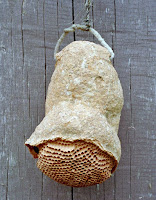The small Potter Nest Collection of the CID Institute Museum was obtained during the years 1991 until 2021. It comprises 2 Potter Insect Nests and a single breeding chamber from Colombia and two single breeding chambers from Germany. Several more colombian specimen got lost during removals in Colombia in 2002. Between those protrude an elsewhere described and documented nest of Eumenes wagnerianus and potter nests of Trypoxylon sp. found at Salado Creek Valley at Envigado in 2002. Furthermore got lost during removals from PLAN Office at Bogotá 1st of May Quarter the single breeding chambers of undeterminated potter wasps collected at Cucuta in January 2000. Also as lost figure breeding nest chambers of ground-nesting potter bees found in 1991 at Pont Saint Nicolas, Gardon River, France.
As most amazing document of filigrane insect clay artwork figures a potter-wasp tribe nest found 1991 at Guaduas Colombia attached to a Guajave Tree branch. The nest is a donation of the garden owner, Mrs. Blanca Monroy de Bonilla, to the nature collection and was transported with great careful attention to Germany. The nest shows fine hexagone breeding chambers made of clay in the inside of a millimeter thin clay nest wall that surrounds the brood comb. In Germany beeing known in the entomologist scene at that time only more thick-walled and less detailled sculptured potter nest structures as constructed for example by Sceliphron and Trypoxylon species, the existence of a so amazing fine clay brood comb design comparable to similar paper wasp nest structures excited greater attention.
In Germany at that time the generally accepted doctrine in entomological teaching attributed the use of earthen material for insect nest construction exclusively to a limited number of solitary bee and wasp species that construct single or attached clay combs but no "nests" in the literally meaning of that term. The possibility that social communities of bees or wasps use the technique of preparing clay for the erection of their much more complex nest structures was widespread discarded, based on the regional knowledge about European insect species. The existence of tropical wasp species that manage the collection and preparation technique of earthen construction material for the fine outlined design of their nest walls and breeding chambers was questioned and the existence of hexagone honeycombs made of clay in social wasp nest was still considered as impossible.
Clay Nest constructed by Social Wasps from Guaduas / Colombia 1991
Donation to CID Institute Museum Entomological Collection by Mrs Blanca Monroy de Bonilla
Clay Nest from Santa Marta, Colombia
Constructor probably is a Bombus species nesting underground
The nest is a donation to CID Institute Museum by Mrs. Myriam Reina 1999
Probable Potter-Bombus sp. Clay Nest with hexagone breeding combs and remaining pupation envelopes
The fine structure of the nests ground shows it´s architectonic structure composed by circular added clay plugs
Sand covered single clay breeding comb of an unidentified potter insect, probably a solitary bee species
Santa Marta / Colombia 1999
Donation to CID Institute Museum Entomological Collection by Myriam Reina
Single breeding comb of a potter bee, maybe Osmia sp., from a half-timbered housewall in Weilmünster 2012
Single breeding comb from a potter wasp, probably Ancistrocerus sp. or Eumenes sp., from the roof of CID Institute 2020
Formerly to the CID Institute Museum Entomological Collection belonging Potter nests that actually are registered as missing :
Breeding combs of a solitary Potter Bee (probably Megachile or Chalicodoma sp.)
Pont Saint Nicolas, Gardon River, France, 1991
Breeding combs probably of a Sphecid Waspe (Hymenoptera : Sphecidae)
Santa Marta, Colombia 1999 / Donation of Mrs. Myriam Reina
Potter Wasp Breeding Combs probably constructed by a wasp species from Pompilidae family
Cucuta 2000 / Donation to CID Institute Museum by Mrs. Myriam Reina
Near the collected 4 potter nest specimen was registered a wasp probably belonging to Pompilidae family constructing a similar breeding comb at the house wall.
If the probably Pompilid wasp species at the nests entrance is also the nest constructor could not be proofed.
Eumenidae and Sphecidae nests from El Salado River near Envigado 2002
Abandoned Organ-Pipe-Nest probably constructed by a Sphecid wasp (Trypoxylon sp.) and Eumenidae-Nests from Eumenes wagnerianu.s.
An erroneously also collected, still occupied nest from Eumenes (Brachymenes) wagnerianus is described more detailled in the parallel publication
THE HISTORY OF THE WASP EUMENES WAGNERIANUS































Keine Kommentare:
Kommentar veröffentlichen